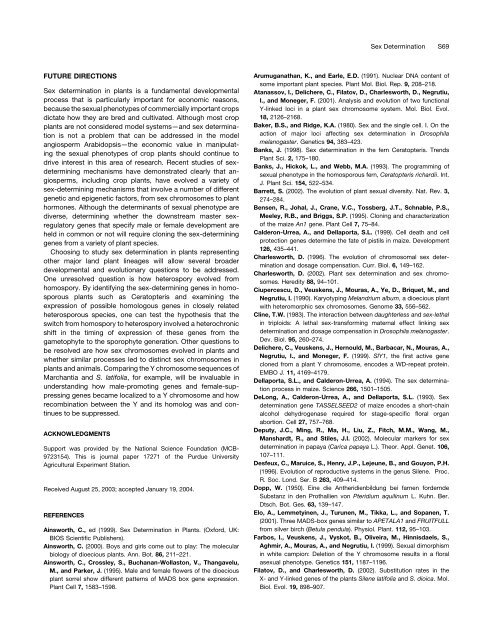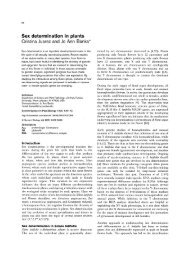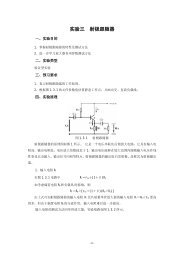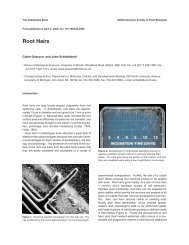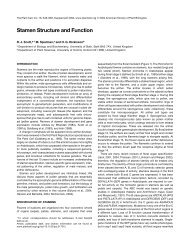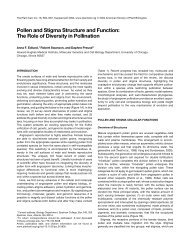Sex-Determining Mechanisms in Land Plants - Barley World
Sex-Determining Mechanisms in Land Plants - Barley World
Sex-Determining Mechanisms in Land Plants - Barley World
You also want an ePaper? Increase the reach of your titles
YUMPU automatically turns print PDFs into web optimized ePapers that Google loves.
<strong>Sex</strong> Determ<strong>in</strong>ationS69FUTURE DIRECTIONS<strong>Sex</strong> determ<strong>in</strong>ation <strong>in</strong> plants is a fundamental developmentalprocess that is particularly important for economic reasons,because the sexual phenotypes of commercially important cropsdictate how they are bred and cultivated. Although most cropplants are not considered model systems—and sex determ<strong>in</strong>ationis not a problem that can be addressed <strong>in</strong> the modelangiosperm Arabidopsis—the economic value <strong>in</strong> manipulat<strong>in</strong>gthe sexual phenotypes of crop plants should cont<strong>in</strong>ue todrive <strong>in</strong>terest <strong>in</strong> this area of research. Recent studies of sexdeterm<strong>in</strong><strong>in</strong>gmechanisms have demonstrated clearly that angiosperms,<strong>in</strong>clud<strong>in</strong>g crop plants, have evolved a variety ofsex-determ<strong>in</strong><strong>in</strong>g mechanisms that <strong>in</strong>volve a number of differentgenetic and epigenetic factors, from sex chromosomes to planthormones. Although the determ<strong>in</strong>ants of sexual phenotype arediverse, determ<strong>in</strong><strong>in</strong>g whether the downstream master sexregulatorygenes that specify male or female development areheld <strong>in</strong> common or not will require clon<strong>in</strong>g the sex-determ<strong>in</strong><strong>in</strong>ggenes from a variety of plant species.Choos<strong>in</strong>g to study sex determ<strong>in</strong>ation <strong>in</strong> plants represent<strong>in</strong>gother major land plant l<strong>in</strong>eages will allow several broaderdevelopmental and evolutionary questions to be addressed.One unresolved question is how heterospory evolved fromhomospory. By identify<strong>in</strong>g the sex-determ<strong>in</strong><strong>in</strong>g genes <strong>in</strong> homosporousplants such as Ceratopteris and exam<strong>in</strong><strong>in</strong>g theexpression of possible homologous genes <strong>in</strong> closely relatedheterosporous species, one can test the hypothesis that theswitch from homospory to heterospory <strong>in</strong>volved a heterochronicshift <strong>in</strong> the tim<strong>in</strong>g of expression of these genes from thegametophyte to the sporophyte generation. Other questions tobe resolved are how sex chromosomes evolved <strong>in</strong> plants andwhether similar processes led to dist<strong>in</strong>ct sex chromosomes <strong>in</strong>plants and animals. Compar<strong>in</strong>g the Y chromosome sequences ofMarchantia and S. latifolia, for example, will be <strong>in</strong>valuable <strong>in</strong>understand<strong>in</strong>g how male-promot<strong>in</strong>g genes and female-suppress<strong>in</strong>ggenes became localized to a Y chromosome and howrecomb<strong>in</strong>ation between the Y and its homolog was and cont<strong>in</strong>uesto be suppressed.ACKNOWLEDGMENTSSupport was provided by the National Science Foundation (MCB-9723154). This is journal paper 17271 of the Purdue UniversityAgricultural Experiment Station.Received August 25, 2003; accepted January 19, 2004.REFERENCESA<strong>in</strong>sworth, C., ed (1999). <strong>Sex</strong> Determ<strong>in</strong>ation <strong>in</strong> <strong>Plants</strong>. (Oxford, UK:BIOS Scientific Publishers).A<strong>in</strong>sworth, C. (2000). Boys and girls come out to play: The molecularbiology of dioecious plants. Ann. Bot. 86, 211–221.A<strong>in</strong>sworth, C., Crossley, S., Buchanan-Wollaston, V., Thangavelu,M., and Parker, J. (1995). Male and female flowers of the dioeciousplant sorrel show different patterns of MADS box gene expression.Plant Cell 7, 1583–1598.Arumuganathan, K., and Earle, E.D. (1991). Nuclear DNA content ofsome important plant species. Plant Mol. Biol. Rep. 9, 208–218.Atanassov, I., Delichere, C., Filatov, D., Charlesworth, D., Negrutiu,I., and Moneger, F. (2001). Analysis and evolution of two functionalY-l<strong>in</strong>ked loci <strong>in</strong> a plant sex chromosome system. Mol. Biol. Evol.18, 2126–2168.Baker, B.S., and Ridge, K.A. (1980). <strong>Sex</strong> and the s<strong>in</strong>gle cell. I. On theaction of major loci affect<strong>in</strong>g sex determ<strong>in</strong>ation <strong>in</strong> Drosophilamelanogaster. Genetics 94, 383–423.Banks, J. (1998). <strong>Sex</strong> determ<strong>in</strong>ation <strong>in</strong> the fern Ceratopteris. TrendsPlant Sci. 2, 175–180.Banks, J., Hickok, L., and Webb, M.A. (1993). The programm<strong>in</strong>g ofsexual phenotype <strong>in</strong> the homosporous fern, Ceratopteris richardii. Int.J. Plant Sci. 154, 522–534.Barrett, S. (2002). The evolution of plant sexual diversity. Nat. Rev. 3,274–284.Bensen, R., Johal, J., Crane, V.C., Tossberg, J.T., Schnable, P.S.,Meeley, R.B., and Briggs, S.P. (1995). Clon<strong>in</strong>g and characterizationof the maize An1 gene. Plant Cell 7, 75–84.Calderon-Urrea, A., and Dellaporta, S.L. (1999). Cell death and cellprotection genes determ<strong>in</strong>e the fate of pistils <strong>in</strong> maize. Development126, 435–441.Charlesworth, D. (1996). The evolution of chromosomal sex determ<strong>in</strong>ationand dosage compensation. Curr. Biol. 6, 149–162.Charlesworth, D. (2002). Plant sex determ<strong>in</strong>ation and sex chromosomes.Heredity 88, 94–101.Ciupercescu, D., Veuskens, J., Mouras, A., Ye, D., Briquet, M., andNegrutiu, I. (1990). Karyotyp<strong>in</strong>g Melandrium album, a dioecious plantwith heteromorphic sex chromosomes. Genome 33, 556–562.Cl<strong>in</strong>e, T.W. (1983). The <strong>in</strong>teraction between daughterless and sex-lethal<strong>in</strong> triploids: A lethal sex-transform<strong>in</strong>g maternal effect l<strong>in</strong>k<strong>in</strong>g sexdeterm<strong>in</strong>ation and dosage compensation <strong>in</strong> Drosophila melanogaster.Dev. Biol. 95, 260–274.Delichere, C., Veuskens, J., Hernould, M., Barbacar, N., Mouras, A.,Negrutiu, I., and Moneger, F. (1999). SlY1, the first active genecloned from a plant Y chromosome, encodes a WD-repeat prote<strong>in</strong>.EMBO J. 11, 4169–4179.Dellaporta, S.L., and Calderon-Urrea, A. (1994). The sex determ<strong>in</strong>ationprocess <strong>in</strong> maize. Science 266, 1501–1505.DeLong, A., Calderon-Urrea, A., and Dellaporta, S.L. (1993). <strong>Sex</strong>determ<strong>in</strong>ation gene TASSELSEED2 of maize encodes a short-cha<strong>in</strong>alcohol dehydrogenase required for stage-specific floral organabortion. Cell 27, 757–768.Deputy, J.C., M<strong>in</strong>g, R., Ma, H., Liu, Z., Fitch, M.M., Wang, M.,Manshardt, R., and Stiles, J.I. (2002). Molecular markers for sexdeterm<strong>in</strong>ation <strong>in</strong> papaya (Carica papaya L.). Theor. Appl. Genet. 106,107–111.Desfeux, C., Maruice, S., Henry, J.P., Lejeune, B., and Gouyon, P.H.(1996). Evolution of reproductive systems <strong>in</strong> the genus Silene. Proc.R. Soc. Lond. Ser. B 263, 409–414.Dopp, W. (1950). E<strong>in</strong>e die Antheridienbildung bei farnen forderndeSubstanz <strong>in</strong> den Prothallien von Pteridium aquil<strong>in</strong>um L. Kuhn. Ber.Dtsch. Bot. Ges. 63, 139–147.Elo, A., Lemmety<strong>in</strong>en, J., Turunen, M., Tikka, L., and Sopanen, T.(2001). Three MADS-box genes similar to APETALA1 and FRUITFULLfrom silver birch (Betula pendula). Physiol. Plant. 112, 95–103.Farbos, I., Veuskens, J., Vyskot, B., Oliveira, M., H<strong>in</strong>nisdaels, S.,Aghmir, A., Mouras, A., and Negrutiu, I. (1999). <strong>Sex</strong>ual dimorphism<strong>in</strong> white campion: Deletion of the Y chromosome results <strong>in</strong> a floralasexual phenotype. Genetics 151, 1187–1196.Filatov, D., and Charlesworth, D. (2002). Substitution rates <strong>in</strong> theX- and Y-l<strong>in</strong>ked genes of the plants Silene latifolia and S. dioica. Mol.Biol. Evol. 19, 898–907.


